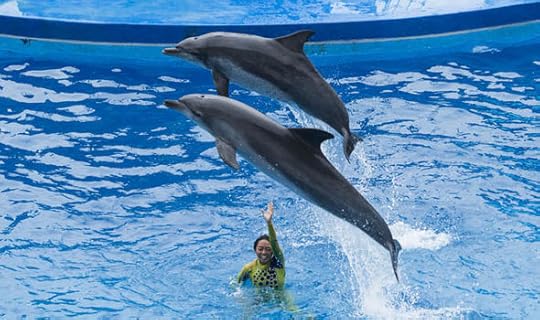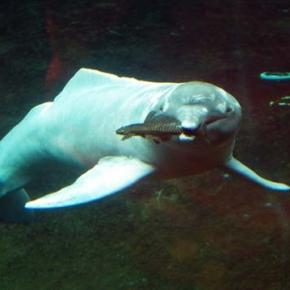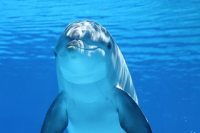Mark Caney's Blog, page 12
October 13, 2015
Rare Albino Dolphin Calf Spotted in California, After Long Absence
People sailing in California’s Monterey Bay might be in for a rare treat: An albino dolphin has been spotted in the area in recent weeks.
Those aboard the Blue Ocean Whale Watch first spotted the unusual dolphin in January. It then disappeared until late September, when it made an appearance with its mother and a number of relatives:
According to Discovery News, the baby dolphin is a local celebrity and as such, the sighting is a cause for celebration.
This calf is a Risso’s dolphin, sometimes also called a gray dolphin because of its coloring. They can grow up to 13 feet long and weight as much as 1,100 pounds. Typically, Risso’s dolphins are born darker and their color fades with time to a pale gray. Because this dolphin is albino, it’ll stay pale for the duration of its life.
It’s not unusual that the whale watch spotted the Risso’s traveling together: They usually move in groups of 10 to 30, though sightings of several hundred and even a thousand of the sea creatures have been reported.
There isn’t much known about how Risso’s dolphins migrate, though theNational Oceanic and Atmospheric Administration notes they have been found around the world, including in the Gulf of Mexico, Norway, Argentina and New Zealand.
In early September, an albino bottlenose dolphin was spotted in the Calcasieu Lake in Louisiana, but in an unusual twist, it appeared pink instead of white. A boat charter service captain, Erik Rue, spotted the unusual animal and dubbed it Pinky.
Source: Newsweek

September 24, 2015
Seaworld fact check website released
I would like to announce a new website – www.seaworldfactcheck.com – a product of several animal protection advocates and myself and Dr. Ingrid Visser. We have launched this site to clarify and correct misinformation presented in SeaWorld Entertainment’s Twitter campaign, AskSeaWorld. The site is meant to serve as a resource for students, the media, policy-makers, and anyone else interested in accurate information on captive cetacean welfare.

September 23, 2015
Win a copy of Dolphin Way in free competition
Goodreads Book Giveaway

Dolphin Way
by Mark Caney
Giveaway ends October 24, 2015.
See the giveaway details
at Goodreads.

September 22, 2015
Think twice before seeing dolphin shows says leading marine life expert
One of the world’s leading marine life experts is asking families to think twice about watching captive dolphin displays when they are travelling abroad.
The plea comes from Dr Joan Gonzalvo who has carried out new research to dispel the myth that dolphins’ natural lives can be replicated in artificial tanks.
He has been studying wild dolphins for more than 15 years and is now dismantling the idea that their needs can be met in dolphinaria.
His latest report was released today by the Born Free Foundation and the Italian animal protection association, Lega Anti Vivisezione, to challenge the idea that keeping dolphins in captivity is acceptable.
r Gonzalvo’s findings were presented in the second of four scientific papers by the bottlenose dolphin expert.
His paper, What About Dolphins in Captivity, spells out the reasons why cetaceans should not be held captive, explaining how they are intelligent, cognitive animals with good memories, self-awareness and can problem solve.
Dr Gonzalvo added: “I invite those considering visiting a dolphinarium with their children to think twice about the message we want to give to future generations.
“Do we have any right to hold a highly evolved, intelligent and sensitive animal captive, to force it to conduct a rather clownish behaviour by performing tricks and stunts for our entertainment?
“If that is the case, we should seriously review our concept of what is entertaining and the kind of relationship that we want to have with nature. Let’s make people conscious about what is hidden behind the frozen smile of a captive dolphin.”

Born Free Foundation, the wildlife charity set up by actors Virginia McKenna and husband Bill Travers, has been a ceaseless campaigner against dolphins in captivity and helped bring the sight of these intelligent sea mammals displaying in dophinaria to an end in the UK, but there are still shows taking place overseas.
Dr Gonzalvo has spent more than 1,000 hours observing dolphin groups in their natural environment.
He says the small concrete tanks of captive dolphins do not compare to the wild because they are mobile, fast-moving and deep-diving mammals sometimes travelling thousands of miles. They also form complex social networks in the wild but, in captivity, are forced into “artificial social groupings determined by humans”.
One of the arguments he also contests is that dolphin shows have an educational purpose.
The documentary Blackfish has had a huge impact on the industry
After examining footage from nine dolphin shows taken at five Italian dolphinaria between 2012 and 2014 to assess their visitor awareness, he says an average of just 10 per cent of shows provided information on the biology and behaviour of cetaceans. No shows included in the study mentioned conservation.
Commenting on the paper, Adam M Roberts, chief executive of the Born Free Foundation, said: “Compassionate conservationists the world over are speaking out against keeping marine mammals in captivity and Dr Gonzalvo’s research provides ample scientific evidence that they are right to do so.
“Since the global launch of the film Blackfish, the captivity industry has been crippled by public awareness – marine mammals belong in the wild: not in concrete tanks; not performing demeaning tricks for gawking onlookers.”
Born Free Foundation is taking its evidence to the European Parliament on behalf of the Dolphinaria-Free Europe coalition.
Source: Express

September 16, 2015
Dolphin Body Slams into Paddle Boarder
Published on 9 Sep 2015
Matt Minich and Peter Nelson paddling and surfing in Hermosa Beach and Manhattan Beach, Ca when a dolphin surfing the waves didn’t see Matt and gave him a body slam. Luckily Matt got the GoPro out when he saw the Dolphin coming in the wave. Fortunately no one was hurt.

September 14, 2015
Dolphins surfing and playing in the waves – HD
Jaimen Hudson caught this footage of a large pod of dolphins swimming at West Beach in Esperance, Western Australia on his drone, showing just how adept the sea mammal is at catching waves and frolicking in the surf …. Dolphin Haze, Esperance Australia.
Videographer Jaimen Hudson was involved in an off-road motorcycle accident which resulted in him relying on a wheelchair for mobility. His love of the ocean and marine life has motivated Jaimen to immerse himself in the wonders of the local coastline, and works as a manager at local diving and fishing company.
Source: LiveLeak

September 4, 2015
Researchers find dolphin fossil in Panama that links it to current day river dolphins
 A newly discovered fossil in Panama is showing scientists that river dolphins had a very interesting evolutionary path as they evolved from living in saltwater ecosystems to freshwater river environments. The fossil of the dolphin’s ancestor is thought to have lived more than six million years ago, and the remains consisted of a part of a skull, two flipper bones, conical teeth and jaw, and a right shoulder blade. They are thought to have similar genes and lived in the Miocene epoch.
A newly discovered fossil in Panama is showing scientists that river dolphins had a very interesting evolutionary path as they evolved from living in saltwater ecosystems to freshwater river environments. The fossil of the dolphin’s ancestor is thought to have lived more than six million years ago, and the remains consisted of a part of a skull, two flipper bones, conical teeth and jaw, and a right shoulder blade. They are thought to have similar genes and lived in the Miocene epoch.
Ancestor of river dolphins was marine inhabitant
The newly discovered river dolphin species was named Isthminia panamensis. This exciting find was located in the Caribbean coastline of Panama and was definitely a marine animal, which is unlike its modern relatives. It was found near other marine fossils, which could explain some of the creatures it ate and where and how it hunted them.
Scientists at the Smithsonian National Museum of Natural History in Washington, DC, say that the shape of the skull, teeth and jaw conform it being a marine animal. It also showed that they were about nine feet long. However, they have also proven that despite it living in the ocean, it is definitely related to modern river dolphins and that they are its closest living relative.
Dolphins moved from salt to fresh environments
Today there are three species of dolphins that live in rivers, with one having recently been declared extinct, which is the Yantze dolphin. When dolphins moved to freshwater environments, they evolved to have broader, more flexible flippers, as well as very long and narrow snouts to help them transverse the winding and more narrow and silty waters of the rivers they live in.
The fossils are said to be helping researchers learn about the marine ancestry of the dolphins living in freshwater and to also find out more about the geographic aspects of that time era. The fact that these dolphins went from salt to freshwater is considered to a backward evolutionary route compared to other marine animals. In most cases, all of the other known whales and dolphin species have gone from being land animals to ocean creatures, meaning that these dolphins had a very complicated evolutionary background.
The evidence has suggested that there were once many different kinds of these dolphins and they say the new fossil will help pinpoint the exact timeframe the dolphins went from being saltwater dwellers to being fresh water mammals.
Source: Blasting News

September 2, 2015
How smart are dolphins – a quick overview from TEDEd
August 22, 2015
Wild Dolphin Gives Snorkelers The Show Of Their Lives
It’s no secret that dolphins are among nature’s most skilled swimmers — but their grace and athleticism isn’t limited to amazing underwater feats.
Snorkelers in Hawaii were recently treated to an extraordinary exhibition of one dolphin species’ acrobatic ability. While exploring the waters off the Big Island, the group was visited by several spinner dolphins, one of whom was gracious enough to dazzle them with a stunning series of airborne barrel rolls.
Best of all, the whole free show was caught on film.
Source: The Dodo

August 19, 2015
Hamas Claims Captured Dolphin Is Israeli Spy
 Hamas has captured a dolphin that it believes was working for Israeli spy agency Mossad, it has been claimed.
Hamas has captured a dolphin that it believes was working for Israeli spy agency Mossad, it has been claimed.
According to reports the dolphin was captured several weeks ago, and was said to have been equipped with “spying equipment” including cameras.
A Hamas source’s claims were publicised by Israel’s Army Radio which made clear that while Israel has a fleet of Dolphin class submarines, Hamas was specifically referring to capturing the mammal.
Hamas said the dolphin was picked up by Hamas’ military wing, the Ezzedine al-Qassan Brigades. The animal’s fate is not known.
The Palestinian newspaper Al Quds reported that the commandos became wary when they spotted the dolphin making “suspicious movements” just outside the port of Gaza.
It claimed that Hamas suspects the dolphin was used to film the training of naval commandos, and said the dolphin was fitted with a type of dart gun.
Claims that Israel is using animals for espionage purposes are not new – in 2012 an eagle with an Israeli tag was captured in Sudan with locals claiming it was a Mossad spy.
In 2010 Egypt said several Israel-controlled sharks may have been involved in attacks on tourists in the Red Sea.
And twice in recent years Turkish media have highlighted birds tagged with Israeli university tracking devices as being on potential espionage missions.
It is the first time that dolphins – known as one of the world’s most intelligent animals – have been accused of being in the employ of Mossad.
Source: Sky News






